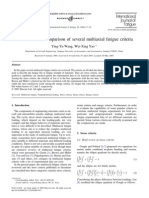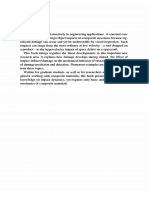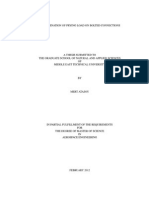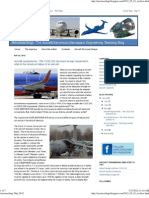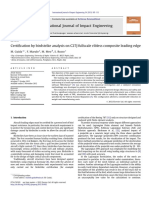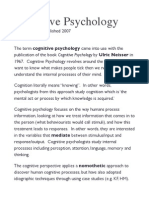Structural Analysis of Spar Madeup of Carbon Fibre Composite Material
Structural Analysis of Spar Madeup of Carbon Fibre Composite Material
Uploaded by
VarunCopyright:
Available Formats
Structural Analysis of Spar Madeup of Carbon Fibre Composite Material
Structural Analysis of Spar Madeup of Carbon Fibre Composite Material
Uploaded by
VarunOriginal Description:
Copyright
Available Formats
Share this document
Did you find this document useful?
Is this content inappropriate?
Copyright:
Available Formats
Structural Analysis of Spar Madeup of Carbon Fibre Composite Material
Structural Analysis of Spar Madeup of Carbon Fibre Composite Material
Uploaded by
VarunCopyright:
Available Formats
International Conference on Interdisciplinary Engineering & Sustainable Management Sciences
(ICMIE13) on 22nd & 23rd February 2013
STRUCTURAL ANALYSIS OF SPAR MADEUP OF
CARBON FIBRE COMPOSITE MATERIAL
Prof.R.Arravind1, Dr.M.Saravanan2 , R.Mohamed Rijuvan3
1
Department of Aeronautical Engineering, Excel College of Engineering & Technology, Tamil Nadu, India
2
Principal, SBM College of Engineering & Technology, Tamil Nadu, India
3
Final Year, B.E Aeronautical Engineering, Excel College of Engineering & Technology, Tamil Nadu, India
email id : arravind_r@rediffmail.com, drmsaravanan@yahoo.com , rijuvanaero09@gmail.com,
ABSTRACT: The Spar is a structure the wing structure that supports an aircraft on ground and allows it to
taxi, take-off, and land. In fact, Spar design tends to have several interferences with the aircraft structural
design. Now a day, strength and the weight of Spar has become an important factor. Efforts are being made
to reduce the weight of the aircraft and consequently increase the payload. This paper presents an approach
to optimize the design of Spar of an Unmanned Aerial Vehicle (UAV) made of Carbon Fibre Composite
material adopted from Aerospace Specification Metals(ASM). First the structural behavior is tested using the
structural analysis when subjected to behavior constraints. Optimization process is carried out iteratively to
minimize thickness of Spar which results in the minimum weight of Spar.
Keywords: Spar, Structural Analysis, Tensile Stress, Compression Stress, Deformation
forces and neglected the drag force acting on it. The
crack generation in the Spar components was
observed by Fujimoto [3] and the basic causes of
damage were found to be processing operations,
latent material defects, mechanical damage and crack
growth developed at corrosion pits. The aircraft Spar
simulation was analyzed by Derek Morrison et al. [4]
by performing two types of analysis. The first is
kinematic evaluation of front nose gear and other is
the structural study of main Spar for a light weight
aircraft. The approach for modeling and simulating
Spar systems was proposed by James Daniels [5]
devolved a nonlinear model of an A-6 intruder main
gear, the simulation and validation was performed
against the static and dynamic test data. A discussion
has been done on problems facing by the aircraft
community in Spar dynamics, especially in shimmy
and brake-induced vibration by Jocelyn Pritchard [6],
experimentally validated and characterized the
shimmy and brake-induced vibration of aircraft Spar.
The design analysis of Light Spar was presented by
Amit Goyal [7]. In the development phase,
conducting a rigorous non-linear stress and buckling
analysis was carried out and also conducting various
experimentations on different combinations of loads
and orientations. Noam Eliaz et al. [8] discussed
failure of beams of Spar during operation. During
replacement of a wheel on the aircraft, a crack was
1.0 INTRODUCTION:
Each type of aircraft needs a unique Spar
with a specific structural system, which can complete
the demands described by unique characteristics
associated with each air craft. The Spar is the
component that supports an aircraft and allows it to
withstand the all kinds of loads acting during takeoff
and landing. The Spar Structure comprises a simple
single piece of Carbon Fibre leaf type which is bolted
at the bottom of the fuselage.
The design and development of a Spar
encompasses several engineering disciplines such as
structures, mechanical systems, aerodynamics,
material science, and so on. The conventional Spar
design [1] and development for aerospace vehicles is
based on the availability of several critical
components/systems such as forgings, machined
parts, mechanisms, sheet metal parts, electrical
systems, hydraulic systems, and a wide variety of
materials such as aluminum alloys, steel and
titanium, beryllium, and polymer composites. As the
science of materials is progressing continuously it is
natural that the use of new materials will replace
older designs with new ones. Energy absorption and
crashworthy features are the primary design criteria
that govern the development of Spars. The impact
force on Spar has been discussed by Flugge [2]
considering both the landing and taxiing impact
International Conference on Interdisciplinary Engineering & Sustainable Management Sciences
(ICMIE13) on 22nd & 23rd February 2013
found on the rear axle bore of the left-hand main Spar
truck beam. The aero structure analysis on ME 548
was analyzed by Dave Briscoe [9] verified that the
vonmises and deflections of Spar and also proved
that results given by the ANSYS and SOLID
WORKS software are not same because of improper
meshing of components. The specific constrained
layer damping applications for cantilever-loaded steel
spring Spar was investigated by Oraig Gellimore
[10]. This work involves validation of the cost
efficient design of traditional Spar damping devices
when used in constrained layer damping. The
dynamic analysis of Spar for critical work conditions
by applying finite element analysis was analyzed by
Jerzy Malachowski [11].
Figure 2.1: Spar
Figure 2.1 shows the model of Spar structure
chosen for analysis which have been used for
Ceanna140, RV-8 type vehicles and at present these
are used in UAV. The weight of Spar considered for
analysis was taken as 6 kg.
The design of light Spar by conducting
structural analysis and design optimization was
analyzed by Essam Albahkali and Mohammed
Alqhtani [12] by conducting experiments on Spar
using impact analysis.
Review of literature survey on different
types of Spars shows that Spar is analyzed for safety
of the structure and effort was made to identify the
faults occurring in them. However there is limited
literature available on conventional Spar made of
ASM7075-T6 material. The present study deals with
the structural analysis and optimization of Spar made
of ASM7075-T6 material and the analysis was
carried out using ANSYS (Version 13).
2.0 GEOMETRICAL MODEL:
The undercarriage or Spar in aviation is the
component that supports an aircraft on the ground
and allows it to land. Conventional Spar consists of
two wheels adjacent to the aircraft's centre of gravity
and a third wheel at the tail. This type of Spar is most
often used in older generation aviation airplanes and
now a days it is used in UAV.
The following are assumptions to be considered for
analysis
The material is assumed to elastic and
homogenous.
The analysis has been carried out with in
elastic limits.
Both Solid (pipe element) and shell elements
are used for analysis.
Rigid Body Element (RBE3) connection is
used for load transfer.
Figure 2.2: Geometry of Spar
The data required for designing and weight
of Spar leg has been taken from Grove Aircraft Spar
Systems Inc, which is a complete custom Spar
company manufactures ready to bolt component
design for customer requirements to individual
aircrafts.
2.1 MATERIAL PROPERTIES:
The main consideration when designing
Spar is to decide the type of material to be used.
Aluminum alloys have played a dominant role in
aircraft components for many decades. They offer
good mechanical properties with low weight. Among
the aluminum alloys, the 2024 alloy and 7075 alloy
are perhaps the most used. 7075 alloys (7075-T6,
T6510) have higher strength than the 2024 but lower
fracture toughness. 2024-T3 alloy is used in the
fuselage and lower wing skins, which are prone to
fatigue due to applications of cyclic tensile stresses.
For the upper wing skins, which are subjected to
compressive stresses, fatigue is less of a problem, and
7075-T6 alloy is used. 7075 aluminum alloy's
composition roughly includes 5.6-6.1% zinc, 2.1-
International Conference on Interdisciplinary Engineering & Sustainable Management Sciences
(ICMIE13) on 22nd & 23rd February 2013
2.5% magnesium, 1.2-1.6% copper, and other
materials like silicon, iron, manganese, titanium,
chromium, and some other metals are used less than
one percent. Here we are replaced the aluminum
alloy with Carbon Fibre Composite Material. The
Table 1 shows material properties of Carbon Fibre
Composite Material.
Figure 2.2 shows the 3D model of the Spar which is
meshed in HYPERMESH and applied the boundary
conditions.
Parameters
Value
Density
1.6 g/cm3
Youngs Modulus
70 Gpa
Poissons Ratio
0.10
Table 1: Material properties of Carbon Fibre
Composite Material
2.2 SPAR LOADS:
The design loads applied on aircraft are lift
load, drag load, side load and torsion load. Lift is the
upward force created by the air flow as it passes over
the wing, drag is the retarding force (back ward
force) that limits the aircrafts speed, side load is the
opposing acting in inward direction of gear leg and
torsion load is applied when the air craft structure
rotates. Table 2 shows general design loads
considered to test the Spar.
Table 2: Spar Loads (Design Loads)
Type of load
Value
Take off Load
Tensile +200N
Landing load
Compression -200N
With the above all specifications the model
was designed in CATIA (Ver-11), meshed in
HYPERMESH (Ver-12) and the results are viewed in
ANSYS (Ver-12).
Figure 2.3: Loads applied on Spar
The maximum possible loads which are
given as design loads are applied through RBE3
connection at the axle end spreading to wheel base.
The units are taken in such a way that translational
forces are in newton and torsion moment is
represented in newton-millimeters. The colour code
is used to represent the problem boundary conditions.
3.0 STRUCTURAL ANALYSIS:
There are several types of structural analysis
which play an important role in finding the structural
safety under stress and deformation. From that the
basic structural safety of the component can be found
by analyzing the structure for static and dynamic
loading conditions.
3.1 STATIC ANALYSIS:
A static analysis is used to calculate the
effects of steady loading conditions on a structure,
while ignoring inertia and damping effects, such as
those caused by time-varying loads. This analysis has
been done by applying static loads and results are
presented for the displacements and vonmises
stresses, because vonmises stress theory is the main
Figure 2.2: 3D-meshed model of Spar
International Conference on Interdisciplinary Engineering & Sustainable Management Sciences
(ICMIE13) on 22nd & 23rd February 2013
failure theory to find the failure of the components or
factor of safety in the problem.
Figure 3.2: Vonmises strain plot of axle component
for both tensile and Compression Condition
Figure 3.2 shows the maximum vonmises
stress in axle component is 8.74*10-4 N/mm2. This
result of static analysis shows the maximum stresses
are occuring at the connection region between the
members. The stress obtained is much less the
allowable stress of the structure. The maximum stress
are observed near the curvature connecting to the
wheel axle.
3.2 SPECTRUM ANALYSIS:
In number of instances (e.g. earthquakes,
wave loading) dynamic loading is random in nature
and static methods are used to represent them. One of
such measure is response spectrum. This represents
the response of an equivalent single degree of
freedom system, to a prescribed random dynamic
loading. The response is typically expressed as
displacement across of range for a particular value of
damping. The spectrum analysis is one in which the
results of a modal analysis are used with a known
spectrum to calculate displacements and stresses in
the model. The Spar is further analyzed for spectrum
response. Initially modal analysis is carried out to
find the dynamic stability of the structure. Spectrum
analysis has been carried out at spectrum loading
conditions.
Figure 3.1: Vonmises Stress plot of the
structure for both tensile and Compression Condition
Figure 3.1 shows developed vonmises stress
in the structure. The maximum vonmises stress is
6.148*107 N/mm2. The obtained stresses are less
than yield stress of the material, so structure is safe
for the given loads. The maximum displacement is
0.011 mm. Maximum displacement is taking place at
the loading region.
The result of spectrum analysis using
Single-Point Response Spectrum (SPRS) analysis
shows maximum displacement of 0.209 mm which is
due to combined modal and spectrum loads.
Maximum displacement is observed at the axle end.
This is due to cantilever nature of the support. The
status bar indicates the varying displacements in the
structure.
International Conference on Interdisciplinary Engineering & Sustainable Management Sciences
(ICMIE13) on 22nd & 23rd February 2013
the real constants which can be easily optimized
based on the optimization cycle satisfying the design
requirements. Totally 11 regions were created with
different thickness parameters for optimization. The
analysis is limited to main Spar part. Since the axle
dimension depends on wheel diameter and
suspension, so the axle part is not considered for
optimization.
In ANSYS optimization the zero-order
method which is an advanced method in sub problem
approximation technique with random design
generation type optimization tool performs multiple
loops, with random design variable obtains values at
each loop. A maximum number of loops with a
desired number of feasible loops can be specified.
This tool is useful for studying the overall design
space, and for establishing feasible design sets for
subsequent optimization analysis.
Figure 3.3: Displacements plot of spectrum analysis
for both tensile and Compression Condition
The results viewed by ANSYS solver are 1
or one standard deviation values. These results follow
a gaussian distribution. The interpretation is that
68.3% of the time the response will be less than the
standard deviation value. We can scale the result by 2
times to get the 2 value which gives 95.91% and
3values 99.7% of the time. The default results are
for maximum stress condition for 1 value. By
multiplying 3 times the 1 values, 16.47 Mpa stress
is obtained. But this stress is much smaller than the
allowable stress of the material, hence the structure is
completely safe for the given loads.
Figure 4.1: Splitted model for weight optimization
analysis A number of iterations were performed by
varying the thickness of the component and the
results are obtained with different sets of feasible
thickness data. The lowest design thickness data
obtained in iterative process is optimized.
Dynamic amplification of the input to the
output response of the systems. The uncontrolled
vibration on gear leg lies between 100 to 750 Hz.
4.0 WEIGHT OPTIMISATION OF THE SPAR:
The static and spectrum results indicate that
the obtained stresses are low when compared to
allowable stresses of the material, hence there is a
possibility for optimization of the Spars thickness.
The model with shell elements is considered for the
analysis. Various regions are created by splitting and
by varying thickness. The thicknesses are supplied as
The maximum vonmises stress is around
244.178 Mpa as shown with red colour. The obtained
stresses are minimum at the top region and are
increasing towards the connecting region between
main Spar to the wheel axle. Initial weight of 6 kg is
reduced to 4.1538 kg by the final optimization cycle
for the given loads. So reduction of 1.8462 kg can be
observed.
5.0 CONCLUSIONS:
International Conference on Interdisciplinary Engineering & Sustainable Management Sciences
(ICMIE13) on 22nd & 23rd February 2013
A CAD model of Spar for unmanned aerial
vehicle was made and discretized in to finite element
mesh using HYPERMESH. Design loads were
applied through RBE3 connection in respective
directions. Static and spectrum response analysis
were conducted in ANSYS. The obtained stresses are
much lesser than the allowable stresses of the
material. So design optimization is carried out to
reduce the weight of the component. The Spar weight
was reduced by iterative process using design
optimization analysis in ANSYS from 6 kg to
4.1538kg for the given loading conditions. A
reduction of 1.8462 kg can be observed which
amounts to almost 30% reduction of weight.
6.0 REFERENCES:
[1]. Norman, S. C. Aircraft Spar Design: Principle
and Practices, AIAA Education Series, AIAA,
Washington, D.C., 1988.
[12]. Essam Albahkali & Mohammed Alqahtani
Design of Light Spar, 2011.
Prof. R.Arravind pursuing (Ph.d)
in composite materials , he
completed his Postgraduate in
Aeronautical Engineering at Park
College of Engineering and
Technology , Coimbatore, Tamil
Nadu, India and completed his undergraduate in
aeronautical engineering at Park College of
Engineering and Technology , Coimbatore, Tamil
Nadu, India. At present working as Professor in the
Department of Aeronautical Engineering in Excel
College of Engineering & Technology, Namakkal
District, Tamil Nadu, India.
Dr.M.Saravanan, at present
working as Principal in SBM
College of Engineering &
Technology, India. He got
graduated in B.E: Mechanical
Engineering from PSNA College
of Engineering and Technology,
Dindigul under Madurai Kamaraj University in the
year of 1992, ME in Production Engineering from
Government college of Technology (Bharathiar
University), Coimbatore in 1996 and completed his
Ph.D in the topic Scatter Search algorithm for
Scheduling of various manufacturing Systems. Also
he got his Post graduate diploma in materials
Management (PGDMM) and Diploma in Industrial
Safety (DIS) from Annamalai University during the
year 1993 and 1995 respectively under DDE. He
published 23 technical papers in the referred
International journals , 3 papers in national journals
and presented more than 70 papers in the National
and international conferences. He bagged three
University awards and a State Award for his tireless
services in National Service Scheme for more than 12
years.
[2]. Flugge W, Spar Impact, NACA, TN2743,
9016, 1952.
[3]. Fujimoto W.T, Gallagher J.P, Summary of Spar
Initial Flaws, AFFDL-TR-77-125, 1977.
[4]. Derek Morrison, Gregory Neff and Mohammed
Zahraee, Aircraft Spar simulation and analysis,
American Society for Engineering Education Annual
Conference, 1997.
[5]. James N. Daniels, A Method for Spar Modeling
and Simulation with Experimental Validation ,
NASA Contractor Report 201601, 1996.
[6]. Jocelyn I. Pritchard, An Overview of Spar
Dynamics, NASA/TM-1999-209143 ARL-TR1976.
[7]. Amit Goyal Light Aircraft Main Spar Design
and Development, SAS Tech journals pp. 45-50,
2002.
[8]. Noam Eliaz, Haim Sheinkopf, Gil Shemesh and
Hillel Artzi, Cracking in cargo aircraft main Spar
truck beams due to abusive grinding following
chromium plating, Elsevier Engineering Failure
Analysis, Vol.12, pp. 337347,2005.
[9]. Dave Briscoe,ME 548 Aero structures Final
Project ANSYS Analysis of Spar, 2006.
[10]. Oraig Gellimore Constrained layer damping
treatment design for aircraft landing, 2007.
[11]. Jerzy Malachowski Dyanamical analysis of
Spar for critical work conditions , 2010.
R.
Mohamed
Rijuvan
is
Undergraduate Student pursuing final
year Aeronautical Engineering at
Excel College of Engineering &
Technology, Namakkal District,
Tamil Nadu, India
You might also like
- Subject Link 8 WBDocument20 pagesSubject Link 8 WBJasmine Barrett100% (1)
- Work Immersion Performance AppraisalDocument4 pagesWork Immersion Performance AppraisalLouncemar NaquinNo ratings yet
- Effects of Cure Cycles On Void Content and Mechanical Properties of Composite LaminatesDocument7 pagesEffects of Cure Cycles On Void Content and Mechanical Properties of Composite Laminatesaman guptaNo ratings yet
- Lesson 24 - Laminate Modeling - Rev C PDFDocument20 pagesLesson 24 - Laminate Modeling - Rev C PDFraduga_fbNo ratings yet
- Rapid: Repair Assessment Procedure and Integrated DesignDocument200 pagesRapid: Repair Assessment Procedure and Integrated Designcadnium1No ratings yet
- An Application of DMAIC Methodology For Increasing The Yarn Quality in Textile IndustryDocument16 pagesAn Application of DMAIC Methodology For Increasing The Yarn Quality in Textile IndustryVarunNo ratings yet
- COST - State-Of-The-Art Review On Design, Testing, Analysis and Applications of Polymeric Composite ConnectionsDocument122 pagesCOST - State-Of-The-Art Review On Design, Testing, Analysis and Applications of Polymeric Composite ConnectionsDavid MartinsNo ratings yet
- An Analytical Model For The Strength Prediction of Hybrid (Boltedbonded) Composite JointsDocument9 pagesAn Analytical Model For The Strength Prediction of Hybrid (Boltedbonded) Composite Jointskhudhayer1970No ratings yet
- Hyper SizerDocument16 pagesHyper SizerKamlesh Dalavadi100% (1)
- Towards A Fastenerless All Composite WingDocument10 pagesTowards A Fastenerless All Composite Wingramanolla_1978No ratings yet
- Aluminium Adhesive JointDocument5 pagesAluminium Adhesive JointJournalNX - a Multidisciplinary Peer Reviewed JournalNo ratings yet
- SdarticleDocument14 pagesSdarticleConstantinescu MateiNo ratings yet
- Evaluation and Comparison of Several Multi Axial Fatigue CriteriaDocument9 pagesEvaluation and Comparison of Several Multi Axial Fatigue CriteriaEbrahim AlvandiNo ratings yet
- A Review of Failure Modes and Fracture Analysis of Aircraftcomposite MaterialsDocument13 pagesA Review of Failure Modes and Fracture Analysis of Aircraftcomposite MaterialsAndres Felipe Bello ZapataNo ratings yet
- Factor of Saftey ReportDocument2 pagesFactor of Saftey ReportMohamed ElmaadawyNo ratings yet
- Examples 2 PDFDocument678 pagesExamples 2 PDFSyed Imtiaz Ali ShahNo ratings yet
- Hart Smith Elastic PlasticDocument11 pagesHart Smith Elastic PlasticRonaldor DogbeNo ratings yet
- Hexcel 8552 IM7 Prepreg TestsDocument238 pagesHexcel 8552 IM7 Prepreg Testsar11111111No ratings yet
- Fatigue Damage Analysis of GFRP Composites Using Digital Image CorrelationDocument16 pagesFatigue Damage Analysis of GFRP Composites Using Digital Image Correlation孟嫣然No ratings yet
- Serge Abrate-Impact On Composite Structures (1998) PDFDocument301 pagesSerge Abrate-Impact On Composite Structures (1998) PDFShree Biradar0% (1)
- Imp-Thoupal 2009-Mechanics of Mechanically Fastened Joints in Polymer-Matrix Composite Structures - A Review PDFDocument29 pagesImp-Thoupal 2009-Mechanics of Mechanically Fastened Joints in Polymer-Matrix Composite Structures - A Review PDFJamalDilferozNo ratings yet
- A Study of A356 Aluminium Alloy PropertiesDocument48 pagesA Study of A356 Aluminium Alloy PropertiesRizky HarisandiNo ratings yet
- Shear Corr 2001 PDFDocument20 pagesShear Corr 2001 PDFCHILAKAPATI ANJANEYULUNo ratings yet
- Simulating The Impact Behaviour of CompositeDocument15 pagesSimulating The Impact Behaviour of CompositeSchmetterling TraurigNo ratings yet
- Nonlinear Nite Element Modeling of RC Beams Strengthened With NSM FRP RodsDocument11 pagesNonlinear Nite Element Modeling of RC Beams Strengthened With NSM FRP RodsRosNo ratings yet
- FEA of Radomes PDFDocument7 pagesFEA of Radomes PDFudaykumar8995No ratings yet
- 17-7 Material PDFDocument5 pages17-7 Material PDFJothi ManiNo ratings yet
- Composite Structures: A. Grimaldi, A. Sollo, M. Guida, F. MaruloDocument15 pagesComposite Structures: A. Grimaldi, A. Sollo, M. Guida, F. MaruloSharan KharthikNo ratings yet
- Composite Bolted Joints Analysis Programs - Venkaya PDFDocument11 pagesComposite Bolted Joints Analysis Programs - Venkaya PDFAnonymous 1rLNlqUNo ratings yet
- A Mathematical Formulation and Solution of The OptDocument11 pagesA Mathematical Formulation and Solution of The OptMohsen ManounNo ratings yet
- The Effect of Fiber Architecture On The Mechanical Properties of Carbon-Carbon Fiber CompositesDocument13 pagesThe Effect of Fiber Architecture On The Mechanical Properties of Carbon-Carbon Fiber CompositesBolaji SuberuNo ratings yet
- Accuracy of First - and Second-Order Tetrahedral ElementsDocument8 pagesAccuracy of First - and Second-Order Tetrahedral ElementsKillgusNo ratings yet
- Mil HDBK 2165Document127 pagesMil HDBK 2165jandriolliNo ratings yet
- 1.4 - Precipitation HardeningSteelDocument1 page1.4 - Precipitation HardeningSteelMuhammad Khizer KhanNo ratings yet
- Engineering Failure Analysis: Lucjan Witek, Marek Orkisz, Piotr Wygonik, Daniel N. Musili, Tadeusz KowalskiDocument10 pagesEngineering Failure Analysis: Lucjan Witek, Marek Orkisz, Piotr Wygonik, Daniel N. Musili, Tadeusz KowalskiGholamreza MahmoodiNo ratings yet
- ME45006 1 ElasticityDocument61 pagesME45006 1 ElasticityYUK LAM WONG100% (1)
- Prying ForceDocument133 pagesPrying Forcetigersronnie100% (1)
- Non-Linear Load Balancing: Workshop 9Document18 pagesNon-Linear Load Balancing: Workshop 9sujaydsouza1987No ratings yet
- Trilateral Design and Test Code For Military Bridging and Gap Crossing EquipmentDocument113 pagesTrilateral Design and Test Code For Military Bridging and Gap Crossing EquipmentomermmkaNo ratings yet
- 10 List Group PAT301Document40 pages10 List Group PAT301Dadir AliNo ratings yet
- Advanced Modelling of Bird Strike On High Lift Devices Using Hybrid PDFDocument9 pagesAdvanced Modelling of Bird Strike On High Lift Devices Using Hybrid PDFpreethaNo ratings yet
- Buckling and Fracture Analysis of Composite Skin-Stringer Panel Using Abaqus and VCCT 2005Document5 pagesBuckling and Fracture Analysis of Composite Skin-Stringer Panel Using Abaqus and VCCT 2005SIMULIACorpNo ratings yet
- Damage Tolerance of Laminated Composites Containing An Open Hole and Subjected To Compressive Loadings - Part I - AnalysisDocument42 pagesDamage Tolerance of Laminated Composites Containing An Open Hole and Subjected To Compressive Loadings - Part I - AnalysisEstebanNo ratings yet
- Fatigue Analysis of A P180 Aircraft Main Landing GearDocument12 pagesFatigue Analysis of A P180 Aircraft Main Landing GearEugene OwiNo ratings yet
- Durability Assessment of Welded Structures Based On Welding Simulation With LS-DYNADocument13 pagesDurability Assessment of Welded Structures Based On Welding Simulation With LS-DYNAAmir IskandarNo ratings yet
- Fishing Rod NonLienar AnalysisDocument7 pagesFishing Rod NonLienar Analysissagar0% (1)
- Aeroteaching - May 2012Document7 pagesAeroteaching - May 2012jmgoodmanNo ratings yet
- Rolling Contact FatigueDocument18 pagesRolling Contact Fatigue宋思祺No ratings yet
- Carbon Fiber Reinforced CFRCDocument22 pagesCarbon Fiber Reinforced CFRCVince Carlo C GarciaNo ratings yet
- (E Akay) Numerical Investigation of Stiffened Composite Panel Into Buckling and Post Buckling Analysis Under Combined LoadingDocument151 pages(E Akay) Numerical Investigation of Stiffened Composite Panel Into Buckling and Post Buckling Analysis Under Combined LoadingbayuhotmaNo ratings yet
- Pax To Cargo ConversionDocument3 pagesPax To Cargo ConversionLoveth Chidinma OgbonnaNo ratings yet
- TL 1.16 Material Allowable Strength DataDocument83 pagesTL 1.16 Material Allowable Strength DataMohd Hairie Yusuf100% (1)
- Double Tapered FRP Beam For Automotive Suspension: Leaf SprungDocument22 pagesDouble Tapered FRP Beam For Automotive Suspension: Leaf SprungYogesh ShindeNo ratings yet
- 85021b - Bolted Joints Subjected To Tension ForcesDocument70 pages85021b - Bolted Joints Subjected To Tension ForcesfaqirNo ratings yet
- Graficas Intercambiadores (NTU)Document269 pagesGraficas Intercambiadores (NTU)Junior RodriguezNo ratings yet
- VCCTDocument64 pagesVCCTAli FahemNo ratings yet
- International Journal of Impact Engineering: M. Guida, F. Marulo, M. Meo, S. RussoDocument9 pagesInternational Journal of Impact Engineering: M. Guida, F. Marulo, M. Meo, S. RussoSharan KharthikNo ratings yet
- Damage Mechanics in Metal Forming: Advanced Modeling and Numerical SimulationFrom EverandDamage Mechanics in Metal Forming: Advanced Modeling and Numerical SimulationRating: 4 out of 5 stars4/5 (1)
- Methodologies for Seismic Safety Evaluation of Existing Nuclear InstallationsFrom EverandMethodologies for Seismic Safety Evaluation of Existing Nuclear InstallationsNo ratings yet
- Wind Wizard: Alan G. Davenport and the Art of Wind EngineeringFrom EverandWind Wizard: Alan G. Davenport and the Art of Wind EngineeringNo ratings yet
- GL On CM - Internal CirculationDocument2 pagesGL On CM - Internal CirculationVarunNo ratings yet
- College of Engineering and Technology: Criteria 7Document14 pagesCollege of Engineering and Technology: Criteria 7VarunNo ratings yet
- 18.12.17 To 12.01.18 DTS 'B'Document4 pages18.12.17 To 12.01.18 DTS 'B'VarunNo ratings yet
- Yuva IremosDocument9 pagesYuva IremosVarunNo ratings yet
- OneDocument15 pagesOneVarun100% (1)
- Manuscript Template (Feb 1, 2012)Document2 pagesManuscript Template (Feb 1, 2012)VarunNo ratings yet
- The Six Sigma Dmaic Methodology in LogisticsDocument6 pagesThe Six Sigma Dmaic Methodology in LogisticsVarunNo ratings yet
- JSBM 12086Document21 pagesJSBM 12086VarunNo ratings yet
- Stroboscope: Non-Contact Speed Measurement High Intensity Flashes Direct Speed Reading in RPM No Shaft ModificationDocument1 pageStroboscope: Non-Contact Speed Measurement High Intensity Flashes Direct Speed Reading in RPM No Shaft ModificationVarunNo ratings yet
- Self Study Report 1Document315 pagesSelf Study Report 1VarunNo ratings yet
- Published Paper of IJCAS in 2012-2014Document114 pagesPublished Paper of IJCAS in 2012-2014VarunNo ratings yet
- Information For AuthorsDocument1 pageInformation For AuthorsVarunNo ratings yet
- Rigid BodyDocument38 pagesRigid BodyVarunNo ratings yet
- IJCAS ChecklistDocument2 pagesIJCAS ChecklistVarunNo ratings yet
- Feed BackDocument15 pagesFeed BackVarunNo ratings yet
- Ace Inclusive Sex EdDocument2 pagesAce Inclusive Sex Ed- Zack -No ratings yet
- Factors Influencing The StudentDocument25 pagesFactors Influencing The StudentRj Ay100% (1)
- Imagine Schools Fort Wayne 2010-2011 School CalendarDocument1 pageImagine Schools Fort Wayne 2010-2011 School Calendarnick_roethemeierNo ratings yet
- Cogntive TheoryDocument7 pagesCogntive Theorypantheonacademics100% (1)
- Lesson PlanDocument3 pagesLesson PlanPiotrek TokarzNo ratings yet
- Draft Letter To Region FINAL Dep EdDocument2 pagesDraft Letter To Region FINAL Dep EdLrak EedNo ratings yet
- CollacationsDocument78 pagesCollacationsngochanpro27No ratings yet
- Managing Classroom StructureDocument22 pagesManaging Classroom StructureJennifer SayongNo ratings yet
- Virginia Henderson BiographyDocument13 pagesVirginia Henderson BiographyScribdTranslationsNo ratings yet
- L&T TECHgium® Offers A Unique Platform For Engineering Students To Engage With Real-World Industry ChaDocument3 pagesL&T TECHgium® Offers A Unique Platform For Engineering Students To Engage With Real-World Industry ChaSujit MaliNo ratings yet
- Edexce Ib CambridgeDocument4 pagesEdexce Ib CambridgeAnonymous 6MSekAxCnZNo ratings yet
- English Lesson Plan #2Document8 pagesEnglish Lesson Plan #2marcela lopez de mesaNo ratings yet
- LWR ReviewerDocument9 pagesLWR ReviewerアーロンクリスチャンNo ratings yet
- Organizational Behavior 265 Pages ExcellentDocument265 pagesOrganizational Behavior 265 Pages ExcellentSayed Muhammad Adil ShahNo ratings yet
- Aligning Statistical and Scientific ReasoningDocument3 pagesAligning Statistical and Scientific Reasoningcaejt44No ratings yet
- Eureka Math Grade 3 Module 2 Tips For ParentsDocument2 pagesEureka Math Grade 3 Module 2 Tips For ParentsMann School - Oak Park, ILNo ratings yet
- Story Matters SampleDocument44 pagesStory Matters Samplenicoler111No ratings yet
- Resume Surya+Document7 pagesResume Surya+pramodNo ratings yet
- CB in I.NDocument39 pagesCB in I.NKlaus AlmesNo ratings yet
- Q1 English7 Module 3Document29 pagesQ1 English7 Module 3Allyza SobosoboNo ratings yet
- General Academic Seat MatrixDocument278 pagesGeneral Academic Seat MatrixRamkumar MeganathanNo ratings yet
- Autoevaluation Rubric: Outstanding (4points) Standard (3points) Near Standard (2points) Below Standard (1point)Document1 pageAutoevaluation Rubric: Outstanding (4points) Standard (3points) Near Standard (2points) Below Standard (1point)Jhayo Flores AranzamendiNo ratings yet
- Mbweebly ResumeDocument2 pagesMbweebly Resumeapi-363908443No ratings yet
- Scholarship S: University of Engineering & Technology TaxilaDocument1 pageScholarship S: University of Engineering & Technology TaxilahassanNo ratings yet
- IELTS Essentials - About Your ResultDocument3 pagesIELTS Essentials - About Your ResultSuresh KumarNo ratings yet
- Dien Bandaranto Remedial Pas InggrisDocument17 pagesDien Bandaranto Remedial Pas InggrisDien BandarantoNo ratings yet
- NSTP ReflectionDocument2 pagesNSTP ReflectionElena BacaniNo ratings yet
- Investigation On Pulse Rate1Document8 pagesInvestigation On Pulse Rate1shiean06No ratings yet












